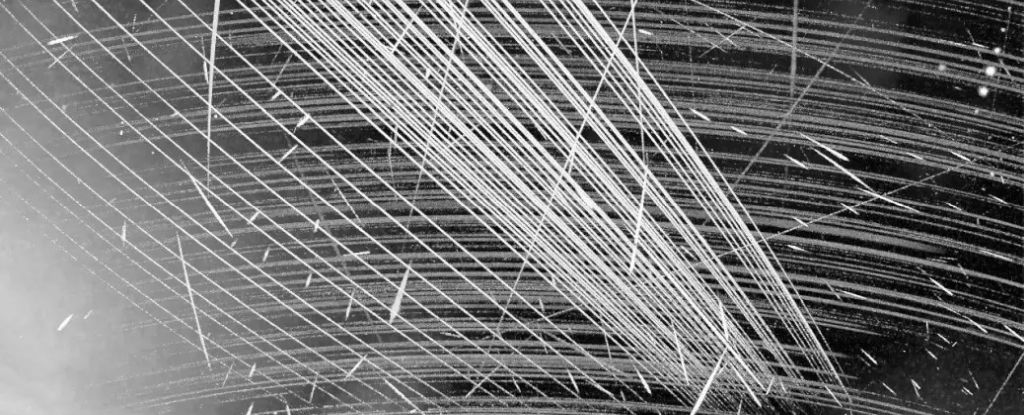Products You May Like
Satellite swarms orbiting the Earth are leaking more radiation into protected wavelength bands than ever.
In fact, the second generation of Starlink satellites – known as the v2mini and v2mini Direct-to-Cell versions – are leaking up to 32 times more radiation than their predecessor.
This is a problem – because some of the radiation they’re leaking is in radio wavelengths that are supposed to be kept clear for the purposes of radio astronomy.
When the problem was first raised in 2023, SpaceX stated that it was working on a fix. Now, with 6,398 individual satellites in orbit at time of writing, the problem has only worsened.
“We have started a program to monitor unintended emission from satellites belonging to different constellations, and our observations show that the second-generation Starlink satellites emit stronger emission and do so over a larger range of radio frequencies, compared to the first-generation satellites,” says astronomer Cees Bassa of the Netherlands Institute for Radio Astronomy (ASTRON).
“Compared to the faintest astrophysical sources that we observe with LOFAR, unintended electromagnetic radiation from Starlink satellites is 10 million times brighter.
“This difference is similar to the faintest stars visible to the naked eye and the brightness of the full Moon. Since SpaceX is launching about 40 second-generation Starlink satellites every week, this problem is becoming increasingly worse.”
frameborder=”0″ allow=”accelerometer; autoplay; clipboard-write; encrypted-media; gyroscope; picture-in-picture; web-share” referrerpolicy=”strict-origin-when-cross-origin” allowfullscreen>
Earth’s skies are growing increasingly more crowded, and it’s becoming more of a concern for our night skies as more and more satellites join the burgeoning swarms.
SpaceX is just one company. OneWeb has 634 satellites. Amazon has plans for more than 3,000. China’s Spacesail Constellation is aiming for 15,000.
The most obvious effect of these satellites is the visible-light streaks they leave on visible-light observations taken at dusk.
But the visible-light pollution isn’t the only kind of light pollution the satellites are generating. A study last year found that constellation satellites are leaking radio waves outside the 10.7-to-12.7 gigahertz range used for communication downlink.
And some of that leakage is in the 150.05-to-153 megahertz (MHz) range used for radio astronomy.
The new study analyzed data from the LOw Frequency ARray (LOFAR) in Europe, a network comprising around 20,000 radio antennas distributed throughout 52 locations.
They used two 1-hour observations with the six central stations of LOFAR, and observed 97 Starlink satellites emitting radio waves in the 110-to-188 MHz frequency range – with emissions from the v2mini versions significantly brighter than those from the first generation of Starlink satellites.
Currently, there are no regulations that address the leakage of unintended electromagnetic radiation from constellation satellites. The researchers strenuously suggest that such regulations be put in place.
Even though the leakage from one or even one swarm of satellites may be minor, the more satellites that enter low-Earth orbit, the brighter the emission will become.
In addition, the researchers urge Starlink to use their data analysis to identify the source of unintended electromagnetic radiation in their satellites and find a way to fix it, before the problem gets even more out of control.
“Humanity is clearly approaching an inflexion point where we need to take action to preserve our sky as a window to explore the Universe from Earth. Satellite companies are not interested in producing this unintended radiation, so minimizing it should also be a priority in their sustainable space policies,” says engineer Federico Di Vruno of the SKA Observatory.
“Starlink is not the only big player in low-Earth orbit, but they have a chance to set the standard here.”
Radio astronomy doesn’t just have implications for space research. The technological advances and discoveries made for and in the study of the cosmos has helped develop technologies that we use here on Earth, too – from Wi-Fi and GPS to medical imaging. Harming radio astronomy would have implications we can’t foresee.
“We just need the regulators to support us, and the industry to meet us half-way,” says ASTRON general and scientific director Jessica Dempsey. “Without mitigations, very soon the only constellations we will see will be human-made.”
SpaceX has not yet responded to ScienceAlert’s request for comment.
The research has been published in Astronomy & Astrophysics.
